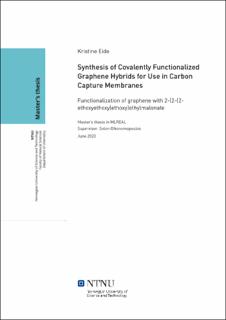Synthesis of Covalently Functionalized Graphene Hybrids for Use in Carbon Capture Membranes
Abstract
For å få bukt med miljøutfordringane som verda står ovanfor i dag kan karbonfangst og lagrings – teknologien (CCS) bli svært viktig for å kunne redusere mengda CO2 i atmosfæren. I dette prosjektet vert det produsert grafen hybridar ved å kovalent funksjonalisere grafen med 2-(2-(2-etoksyetoksy)etoksy)etyletylmalonat for å bruke i «Mixed Matrix Membranes» (MMM) i CCS. Grafen vart produsert ved å sonikere grafitt i NMP ved bruk av «tip-sonication» på 63 W. 2-(2-(2-Etoksyetoksy)etoksy)etyletylmalonat vart syntetisert gjennom ein esterifiserings reaksjon av 2- (2- (2-etoksyetoksy)etoksy)etan-1-ol og etyl-3-klor-3-oksopropanoat via ein nukleofil asylsubstitusjon. Kovalent funksjonalisering av grafen med malonaten vart utført gjennom ein mikrobølge-assistert Bingel reaksjon. Raman spektroskopi og fargen på prøvene indikerte at funksjonalisering hadde skjedd. Optimalisering av funksjonaliseringsreaksjonen blei gjort og det som verka å vere den mest effektive måten var å bruke 0,01 ml malonat, rundt 0,07 g CBr4 og 0,05 ml DBU for 3 ml grafen med ei reaksjonstid på 10 minutt når mikrobølgjer vert nytta. Due to the large emission of CO2, the world is facing environmental challenges. Carbon Capture and Storage (CCS) technology can reduce the amount of CO2 in the atmosphere and research in this field is of great importance. In this project graphene hybrids were made by covalent attachment of 2-(2-(2-ethoxyetoxy)ethoxy)ethylethylmalonate onto graphene for use in Mixed Matrix Membranes (MMM) in CCS. Graphene was made by sonication of graphite in NMP using tip sonication at 63 W. 2-(2-(2-Ethoxyetoxy)ethoxy)ethylethylmalonate was made through an esterification reaction of 2-(2-(2-ethoxyethoxy)ethoxy)ethane-1-ol and ethyl-3-chloro-3-oxopropanoate going through a nucleophilic acyl substitution. The covalent attachment of the malonate was done through a microwave assisted Bingel reaction and Raman spectroscopy and the colour of the samples indicated that functionalization had taken place. Using 0,01 mL of malonate, about 0,07 g CBr4 and 0,05 mL of DBU for 3 mL of graphene with a reaction time of 10 minutes in the microwave seemed to be the most efficient way of functionalizing graphene with the malonate.
